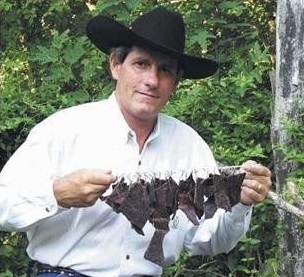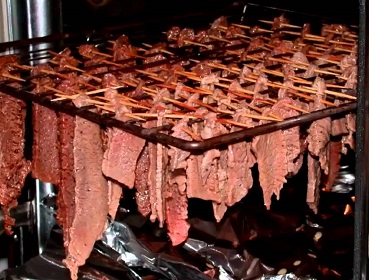Hunting/Food: Making Wild Game Jerky
This is Passport to Texas
May is when Parks and Wildlife celebrates al fresco feasting; also known as picnicking. And, if you’re Larry Burrier, you always pack along some homemade wild game jerky.
08— First off, it’s more nutritional and better for you than everyday snacks. Plus – the most important thing—you know what’s in it.
People who say they don’t like jerky because it’s like trying to eat a leather belt, haven’t had good jerky says Burrier.
08— It’s supposed to be pliable. If you can take a piece of that meat and bend it without it cracking or breaking, that’s when it’s jerky. You don’t want it hard.
From-time-to-time Burrier teaches traditional jerky-making classes at Lockhart State Park. He says making this treat from wild game you’ve harvested brings your food full circle when you eat it outdoors – where it originated.
08— It’s self-sustaining. It teaches them how to live off the land. What to do with the meat after you harvest it. Of course, this state has so much game in it, it’s ridiculous.
Ridiculously delicious, that is. Find a jerky recipe to use with any animal protein, and that requires no special equipment to make, at passporttotexas.org.
We record our series at the Block House. Joel Block engineers our program.
For Texas Parks and Wildlife, I’m Cecilia Nasti.
______________________________________________
Larry Burrier’s Country Style Jerky in the Oven
From Texas Link to Jerky Making
Recipe for use with 8 pounds of venison or lean beef.
Wet Marinade:
2 teaspoons curing salt
2 teaspoons curry powder
3 teaspoons cayenne pepper
4 teaspoons black pepper
8 tablespoons salt
3 tablespoons onion powder
2 tablespoons garlic powder
2 cups soy sauce
2 cups Worcestershire Sauce
3 cups water
Mix all ingredients together to make marinade for your meat.
Directions for preparing meat and making jerky:
1. Trim fat, gristle and membrane from the meat
2. Freeze the trimmed meat for approximately 2-3 hours to make slicing easier.
3. Slice meat into 1/4 to 3/8 inch slices.
4. Place meat in marinade mixture; cover and refrigerate overnight.
5. Once fully marinated, spray your oven with nonstick cooling oil spray, and preheat oven to 140 degrees (or lowest setting for your oven).
6. Place a cookie sheet or aluminum foil on the bottom of your oven to catch the drips.
7. Skewer meat strips with metal or wooden skewers and hang along racks 1/4 inch apart to provide for better heat and smoke circulation (see picture).
8. close the oven door, but use a utensil like a wooden spoon to hold open the door slightly for the first hour, as that allows more air circulation and moisture to escape.
9. After an hour close the door completely and check every hour until your jerky is dried, but flexible enough to bend. Store in air tight containers in your refrigerator.




 Passport to Texas is a
Passport to Texas is a  Passport to Texas is made available by:
Passport to Texas is made available by: